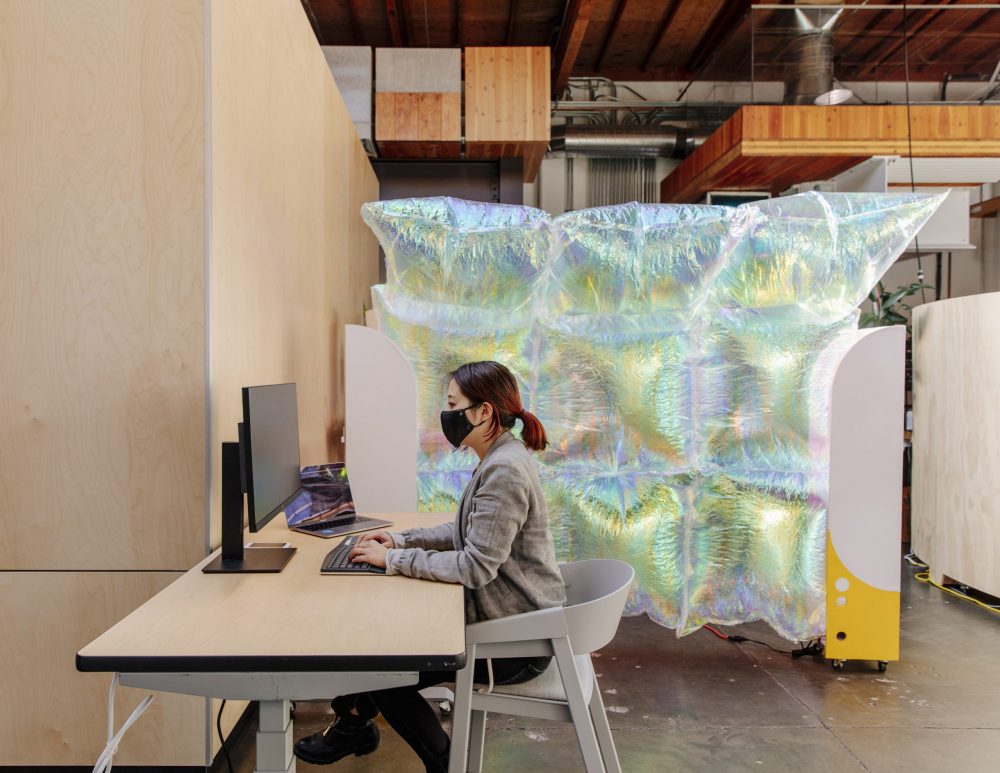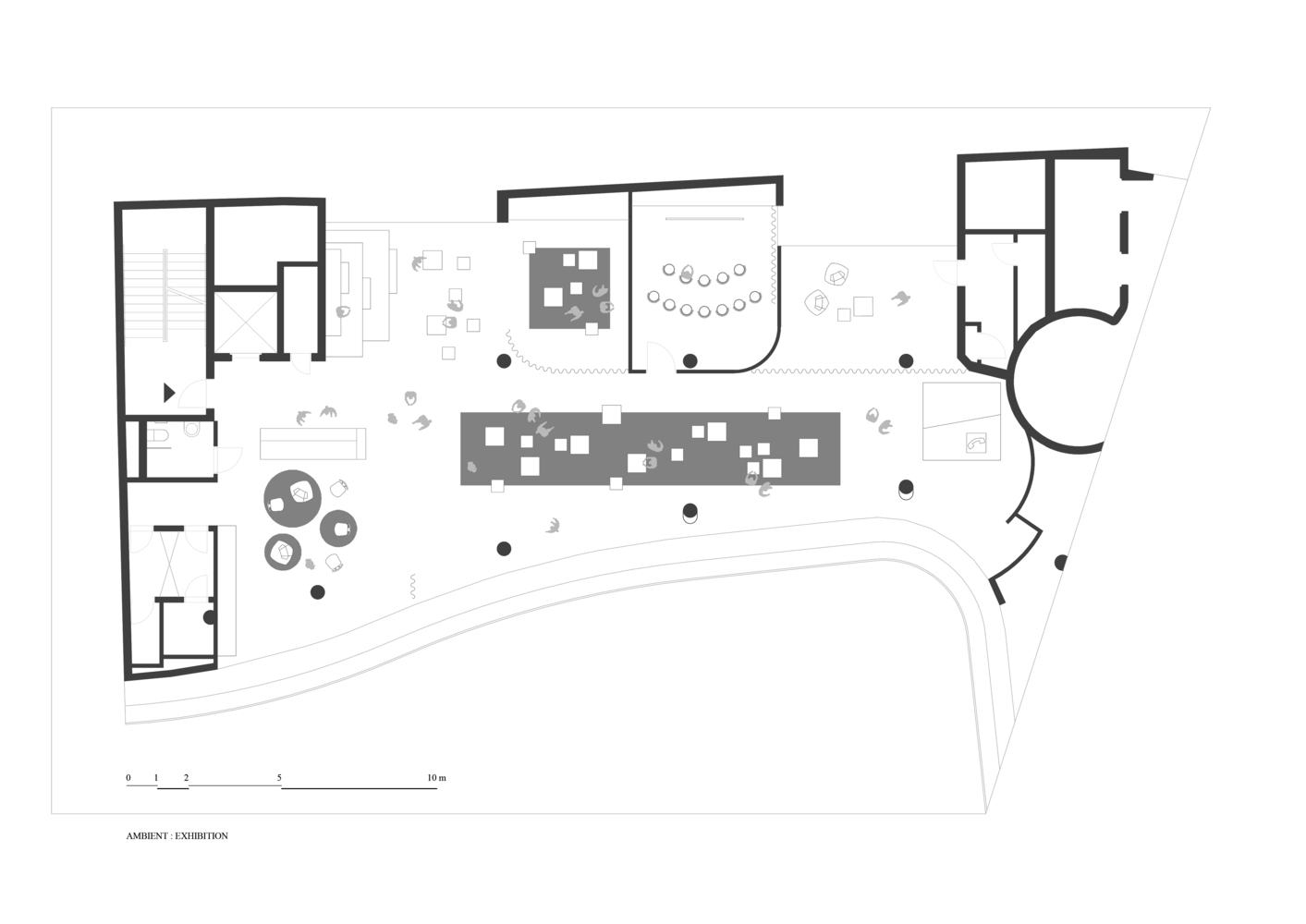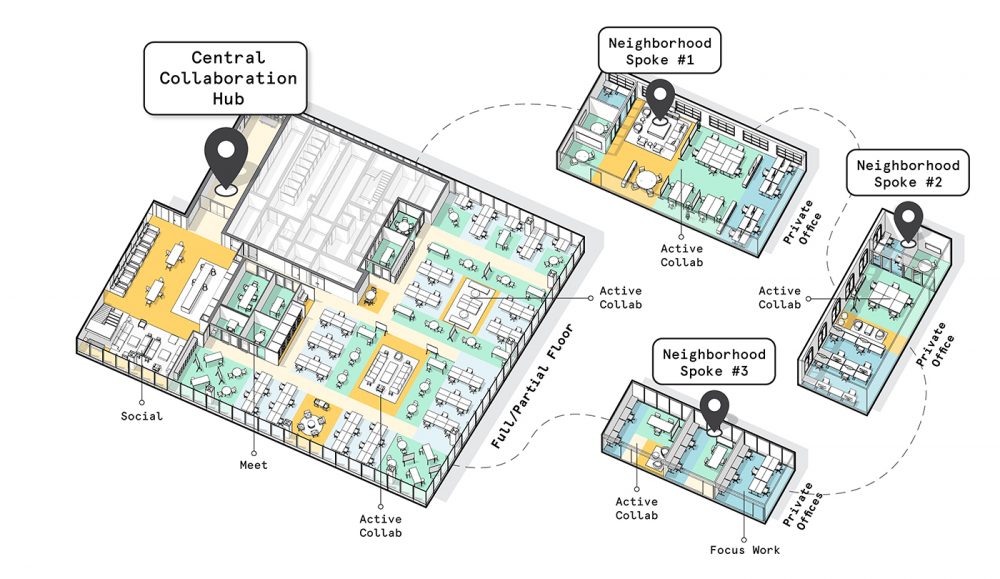Darian Lu explores how the future workplace will be shaped by resilient office designs, decentralization office locations, and employee-oriented work arrangement.
– Happy New Year! Check out all of our 2022 workplaces trends here. –

Pre-pandemic, most companies used centralized office locations for employees to work alongside each other. Today, in most industries, employees have options and are exposed to greater autonomy: giving more thought to how, where and when they want to work. The future of work is where employees can take work with them wherever they want: in the office, at home, or on “workation”. The new post-pandemic workplace normal is being shaped by combinations of 3 tenets: resilient workplace designs, decentralization office locations, and employee-oriented work arrangement.

Resilient Workplace Designs
First there were cubicles, then there was the open office. The kind of “open office” we know was born as an opposite reaction to cubicles. It mainly features no walls and uniform workstations. Proponents claim it to improve face-to face collaborations and eliminate hierarchies which is a main criticism for cubicle offices. Now we’re somewhere in the middle. A mix of open and closed spaces are integrated to accommodate various personalities, work styles, and tasks. Workplace design today is transitioning from being designed for efficiency to being designed for resilience. Building flexibility into workplaces also allows companies to respond to disruptions quickly.
What employees need from a workplace is changing constantly. Global workplace design leaders at WoodsBagot believe the future office maintains open plan layouts, but large groups will be reduced to smaller team communities. Creating studio-size “neighborhoods” using mobile partition systems is an effective way to reduce scale in a massive office. Companies like Google are also thinking of ways to set up team pods and maintain design fluidity through inflatable walls and portable HVAC systems, which are historically among the most rigid elements in an office design. Google developed balloon walls to be shipped flat to offices around the world. The translucent balloon walls automatically blow up for situations where privacy is required. A fabric-based overhead air duct system that attaches with zippers were prototyped to achieve maximum flexibility. The system can be easily altered based on seating arrangements and allows every seat to have its own air diffuser to control the direction or amount of air blowing on it.

What does the workplace become? It is, more than ever, a resource for meeting and collaborating. It is progressively evident that doing creative or transformational work remotely is difficult. Because it requires frequent collaboration. In-office collaboration is also essential to drive innovation through constructive conflict. Open offices are being crafted into activity-based workplaces. A variety of intentional collaboration hubs will replace selected areas of open office and are used as in-office touchdown spaces for project teams. Steelcase identified five work zone categories that contribute to a resilient work environment. These work zones include resident zones for everyday assigned tasks; meeting zones; nomad zones for mobile workers with easy access to data and power; social zones for informal collaborations; and resource zones that offer employee support. Manifesto & reSITE provides a range of multi-function spaces in their office in Prague, engaging employees in various work-related activities. In their otherwise open-floor office, seamless transformations of work zones and effortless transitions between daily tasks are made possible by simple adjustments of textile dividers. A 6-8 people conference room can turn into an all-hands meeting area comfortably hosting 30 people. A simple swap of furniture transforms lounge space to a team room. Space and its functions are being redefined throughout employees’ workdays.


Satellite Offices
Health and wellness focus in post-pandemic workplaces requires offices to be less dense so that employees can stay socially distanced. As a result, most companies will focus on reducing the footprint of headquarter locations and their respective headcounts. Many of the major tech companies are expanding their geographic diversification in second-tier cities or investing in smaller regional “hubs”. In the last couple years, many people were hired at Amazon’s offices in Dallas, Detroit, Denver, and Phoenix – far away from its headquarters in Seattle. Google is also opening new offices in Houston and recently expanded in Atlanta; Chicago; and Madison, Wisconsin. Multiple office locations allow employees to work from near home. The setup gives employees a desirable space with well-equipped office resources in a convenient location that does not require long commutes. WeWork offers a “hub and spoke” model to their clients, in response to the growing priority for geographical practicality and safety while facilitating space for production and focused work. WeWork partnered with an APAC global insurance company needed to continue in-office operations throughout the pandemic to help them strategize transitioning from one central headquarter to several satellite offices across the company’s primary cities. The model offers companies any-time access to 800-plus locations. For example, in New York, most employees live within 15 min walk or bike distance away from at least one satellite office location. As talent scattered during the pandemic, geographically-diverse office locations also give companies an edge to attract the most talented and highly-motivated candidates, without limitations to their physical locations.

Workation is the New Travel Trend
Last but not least, when one can work from anywhere, working from somewhere extraordinary becomes increasingly common. A workation is a vacation that allows you to work remotely by integrating leisure elements that allow you to relax and be more productive. Through telecommuting, one may choose to work from another region, such as a tropical island, and take advantage of the slower times at work to recharge in anticipation of busy times. Many “conventional” workers have begun to arrange their work and life towards that of a digital nomad. Working at WiFi-equipped cottages and cabins away from home was a popular phenomenon we saw during the pandemic. In the first quarter of 2021, Airbnb reported the amount of long-term stays nearly doubled. Since then, Airbnb has shifted its business focus to long-term rentals for getaways and workations.
The pandemic WFH experience has led to substantial changes in our work habits. Increasing numbers of workers believe work happens anywhere and not just in the office. As we become used to remote working, working from anywhere is beginning to be seen as an extension of the office. Whether it’s hot-desking in an address-free workplace, working from an office location of one’s choice, or bringing their work to a remote staycation, employees can take their work wherever they choose. The past year taught us that work is about people. Purposing the office as a series of spaces for collaboration and productivity, and embracing flexible work models is imperative to cultivating a workforce that is both engaging and autonomous.

